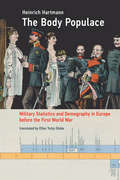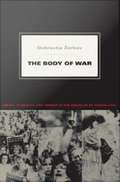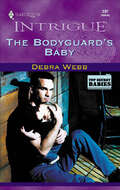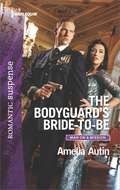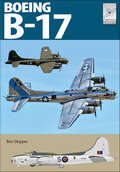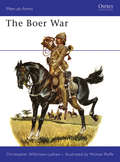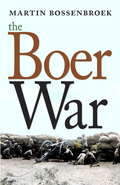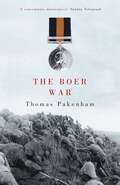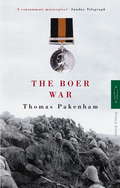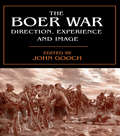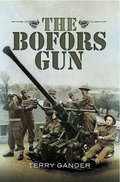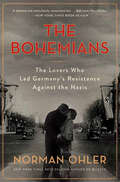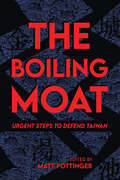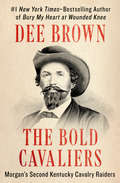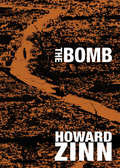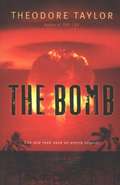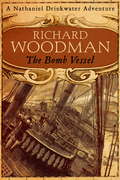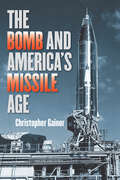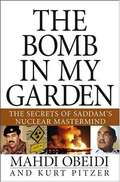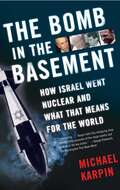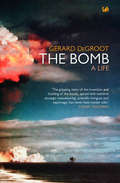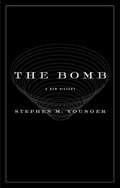- Table View
- List View
The Body Populace: Military Statistics and Demography in Europe before the First World War (Transformations: Studies in the History of Science and Technology)
by Heinrich HartmannHow data gathered from national conscriptions in pre–World War I Europe influenced understandings of population fitness and redefined society as a collective body. In pre–World War I Europe, individual fitness was increasingly related to building and preserving collective society. Army recruitment offered the most important opportunity to screen male citizens' fitness, raising questions of how to define fitness for soldiers and how to translate this criteria outside the military context. In this book, Heinrich Hartmann explores the historical circumstances that shaped collective understandings of fitness in Europe before World War I and how these were intertwined with a fear of demographic decline and degeneration. This dynamic gained momentum through the circulation of knowledge among European nations, but also through the scenarios of military confrontations. Hartmann provides a science history of military statistics in Germany, France, and Switzerland in the decades preceding World War I, considering how information gathered during national conscriptions generated data about the health and fitness of the population. Defined by masculine concepts, conscription examinations went far beyond the individuals they tested and measured. Scholars of the time aspired to pin down the “nation” in concrete numerical terms, drawing on data from examinations to redefine society as a “collective body” that could be counted, measured, and examined. The Body Populace explores the historical specificity and contingency of data-gathering techniques, recounts their uses and abuses, and provides a timely contribution to the growing historiography of Big Data. It sheds light on a crucial moment in nineteenth and early twentieth century European history—when statistical data and demographical knowledge shaped new notions of masculinity, fostered fears of degeneration, and gave rise to eugenic thinking.
The Body of War: Media, Ethnicity, and Gender in the Break-up of Yugoslavia
by Dubravka ŽarkovIn The Body of War, Dubravka Žarkov analyzes representations of female and male bodies in the Croatian and Serbian press in the late 1980s and in the early 1990s, during the war in which Yugoslavia disintegrated. Žarkov proposes that the Balkan war was not a war between ethnic groups; rather, ethnicity was produced by the war itself. Žarkov explores the process through which ethnicity was generated, showing how lived and symbolic female and male bodies became central to it. She does not posit a direct causal relationship between hate speech published in the press during the mid-1980s and the acts of violence in the war. Instead, she argues that both the representational practices of the "media war" and the violent practices of the "ethnic war" depended on specific, shared notions of femininity and masculinity, norms of (hetero)sexuality, and definitions of ethnicity. Tracing the links between the war and press representations of ethnicity, gender, and sexuality, Žarkov examines the media's coverage of two major protests by women who explicitly identified themselves as mothers, of sexual violence against women and men during the war, and of women as militants. She draws on contemporary feminist analyses of violence to scrutinize international and local feminist writings on the war in former Yugoslavia. Demonstrating that some of the same essentialist ideas of gender and sexuality used to produce and reinforce the significance of ethnic differences during the war often have been invoked by feminists, she points out the political and theoretical drawbacks to grounding feminist strategies against violence in ideas of female victimhood.
The Bodyguard's Baby (Top Secret Babies #1)
by Debra WebbHE'D BEEN FULLY PREPARED TO GIVE HIS LIFE TO PROTECT HERS.And that's what it had almost cost bodyguard Nick Foster. Laura Proctor was more than a job to Nick--and they had unfinished business. For two years Laura was suspected dead. Nick hadn't believed it. But he also couldn't believe she'd had a baby in that time...with anyone else but him. Laura would trust Nick with her life, but not with her secret. And she wouldn't go back to Jackson, Mississippi, with him and leave her child in the hands of a kidnapper. Somehow she had to convince Nick that her baby was missing, but that the child wasn't his. Because the closer he got to the truth, the more danger would come to them all.
The Bodyguard's Bride-to-Be
by Amelia AutinA pretend engagement suddenly becomes very real...and dangerous When Tahra Edwards sees a suspicious knapsack near a school yard, she leaps into action...and saves children from a bomb. But upon awakening in a hospital, Tahra discovers she's lost her memory-including any recollection of the handsome military captain who says he's her fiancé. A charming alpha hero who seems to be hiding something... As a high-level bodyguard, Marek Zale knows that a ruthless terrorist organization will stop at nothing to silence Tahra-his ex-girlfriend-permanently. To protect her, he must be by her side around the clock. And though he may not be telling her the truth about their engagement, their love for each other was always true...as is the danger threatening them both!
The Boeing B-17 (FlightCraft #27)
by Ben SkipperThe B-17 Flying Fortress, a term coined by a Seattle Daily Times report in 1935, was a quantum leap in offensive air power. Designed for a nation whose foreign policy was still deeply isolationist, and an Air Corps whose in-service bomber fleet was dominated by bi-planes, the B-17, with its four engines, huge wingspan, enviable payload – almost double that of contemporary bombers – and all metal construction, ushered in a new age. For an aircraft of its size and relative complexity the B-17’s design and development was heralded by a host of key innovations with the unveiling of the XB-15 (Boeing 294), including engine access crawl ways, enhanced endurance and massive load capacity. Within a year the Y1B-17 or Model 299 had refined ideas from the XB-15 and produced a sleek, attractive-looking aircraft. By 1937 all testing had been completed and the first 12 aircraft were delivered to 2nd Bombardment Group for assessment. At the start of the Second World War the still-new B-17 was just beginning to fill the ranks of US bomber squadron’s and by early 1941 the B-17C, arguably the fastest B-17 built, was flying in RAF Service. The B-17 was soon flying over Europe with the newly-created United States Army Air Forces, as well as taking the fight to the Japanese in the Pacific and to the Axis in the Mediterranean. When production of the B-17 was halted in April 1945, at which point the B-17 had been supplanted by the B-24 in the Pacific, over 12,700 B-17s had been built. The type would bow out as a bomber not long after the war’s end, though a few would soldier on as SB-17 air-sea rescue aircraft. Ultimately the B-17 would fly with 26 countries. This Flight Craft title offers the modeler an exciting selection of photographs, illustrations and showcase examples to help build their own version of this icon of the skies.
The Boer War
by Michael Roffe Christopher LathamThis book examines the uniforms, equipment, history and organisation of the armies that fought in the Boer War. Both sides are covered, and the campaigns summarised. Uniforms are shown in full illustrated detail.
The Boer War
by Martin Bossenbroek Yvette RosenbergThe Anglo-Boer War (1899-1902) is one of the most intriguing conflicts of modern history. It has been labeled many things: the first media war, a precursor of the First and Second World Wars, the originator of apartheid. The difference in status and resources between the superpower Great Britain and two insignificant Boer republics in southern Africa was enormous. But, against all expectation, it took the British every effort and a huge sum of money to win the war, not least by unleashing a campaign of systematic terror against the civilian population. In The Boer War, winner of the Netherland's 2013 Libris History Prize and shortlisted for the 2013 AKO Literature Prize, the author brings a completely new perspective to this chapter of South African history, critically examining the involvement of the Netherlands in the war. Furthermore, unlike other accounts, Martin Bossenbroek explores the war primarily through the experiences of three men uniquely active during the bloody conflict. They are Willem Leyds, the Dutch lawyer who was to become South African Republic state secretary and eventual European envoy; Winston Churchill, then a British war reporter; and Deneys Reitz, a young Boer commando. The vivid and engaging experiences of these three men enable a more personal and nuanced story of the war to be told, and at the same time offer a fresh approach to a conflict that shaped the nation state of South Africa.
The Boer War
by Thomas PakenhamThe war declared by the Boers on 11 October 1899 gave the British, as Kipling said, 'no end of a lesson'. The public expected it to be over by Christmas, but it proved to be the longest (two and three-quarter years), the costliest (over £200 million), the bloodiest (at least 22,000 British, 25,000 Boer and 12,000 African lives) and the most humiliating war that Britain fought between 1815 and 1914.Thomas Pakenham's was the first full-scale documentary history of the war to be attempted since 1910. His narrative is based on first-hand and largely unpublished sources, from British and South African archives to the private papers, letters and diaries of the protagonists and soldiers of both sides, and the tape-recorded memories of over fifty survivors. Out of this historical goldmine, Thomas Pakenham has constructed a narrative as vivid and fast-moving as a novel, and throws new light on the blunders and personal feuds of the British generals. He writes movingly of the plight of the 100,000 black Africans who served both armies, and explains the final political victory of the Boers - how they lost the war but won the peace - with far-reaching consequences for Europe and South Africa.
The Boer War: A Boer Journal Of The Anglo-boer War
by Thomas PakenhamFeaturing previously unpublished sources, this 'enjoyable as well as massively impressive' bestseller is a definitive account of the Boer War (Financial Times)The war declared by the Boers on 11 October 1899 gave the British, as Kipling said, 'no end of a lesson'. It proved to be the longest, the costliest, the bloodiest and the most humiliating campaign that Britain fought between 1815 and 1914.Thomas Pakenham's narrative is based on first-hand and largely unpublished sources ranging from the private papers of the leading protagonists to the recollections of survivors from both sides. Mammoth in scope and scholarship, as vivid, fast-moving and breathtakingly compelling as the finest fiction. The Boer War is the definitive account of this extraordinary conflict - a war precipitated by greed and marked by almost inconceivable blundering and brutalities...and whose shattering repercussions can be felt to this very day.'Not only a magnum opus, it is a conclusive work ... Enjoyable as well as massively impressive' -Financial Times'This is a wonderful book: brilliantly written ... the reader turns each page with increasing fascination and admiration' -A.J.P. Taylor
The Boer War: A Boer Journal Of The Anglo-boer War
by Thomas PakenhamFeaturing previously unpublished sources, this 'enjoyable as well as massively impressive' bestseller is a definitive account of the Boer War (Financial Times)The war declared by the Boers on 11 October 1899 gave the British, as Kipling said, 'no end of a lesson'. It proved to be the longest, the costliest, the bloodiest and the most humiliating campaign that Britain fought between 1815 and 1914.Thomas Pakenham's narrative is based on first-hand and largely unpublished sources ranging from the private papers of the leading protagonists to the recollections of survivors from both sides. Mammoth in scope and scholarship, as vivid, fast-moving and breathtakingly compelling as the finest fiction. The Boer War is the definitive account of this extraordinary conflict - a war precipitated by greed and marked by almost inconceivable blundering and brutalities...and whose shattering repercussions can be felt to this very day.'Not only a magnum opus, it is a conclusive work ... Enjoyable as well as massively impressive' -Financial Times'This is a wonderful book: brilliantly written ... the reader turns each page with increasing fascination and admiration' -A.J.P. Taylor
The Boer War: Direction, Experience and Image (Military History and Policy #No. 7)
by John GoochThis collections of essays by leading British and South African scholars, looking at the Boer War, focuses on three aspects: how the British Military functioned; the role of the Boers, Afrikaners and Zulus; and the media presentation of the war to the public.
The Bofors Gun
by Terry GanderThe definitive history of this enduring and versatile anti-aircraft weapon, including many photos and drawings. The 40mm Bofors gun, first produced in the 1930s, has become one of the most famous artillery pieces of all time. It shows no sign of fading from the defense scene as, in the second decade of the twenty-first century, it performs in many roles that were not contemplated by its original designers. It has also proven to be so versatile that it is now allied to electronic and other technological marvels that were mere pipe dreams only a few years ago. When the Bofors entered the international defense market, its primary quarry, the military aircraft, was still a slow and fragile machine that could be terminally damaged by a single hit from a 40mm projectile. Terry Gander describes this early period in the gun&’s development and he shows how, despite recent increases in target speed and other performance parameters, it can still inflict a one-hit kill on almost any aircraft, helicopter or guided missile. Perhaps the most astonishing aspect of the story is that the fundamentals of today&’s Bofors guns remain virtually unchanged from the very first examples to come off the Karlskoga production line in Sweden. In all its forms, the Bofors continues to be a sound, reliable, and lethal piece of military hardware that has given good service to gunners all over the world. Terry Gander&’s comprehensive account of the history of this remarkable weapon over the course of almost eighty years is fascinating reading and an invaluable work of reference for military historians and artillery specialists alike.
The Bohemians: The Lovers Who Led Germany's Resistance Against the Nazis
by Norman Ohler“An astonishing story of the anti-Nazi resistance—a story of love, incredible bravery and self-sacrifice . . . brilliantly told.” —Antony Beevor, New York Times-bestselling author Harro Schulze-Boysen already had shed blood in the fight against Nazism by the time he and Libertas Haas-Heye began their whirlwind romance. She joined the cause, and soon the two lovers were leading a network of anti-fascist fighters that stretched across Berlin’s bohemian underworld. But nothing could prepare Harro and Libertas for the betrayals they would suffer in this war of secrets—a struggle in which friend could be indistinguishable from foe. Drawing on unpublished diaries, letters, and Gestapo files, Norman Ohler spins an unforgettable tale of love, heroism, and sacrifice in The Bohemians.“An unforgettable portrait of two young lovers and their circle of friends in the anti-Hitler resistance, The Bohemians offers a fascinating glimpse of life in Nazi Germany, where the simple self-assertion of youth was a political act, and daily life was a minefield where missteps could have fatal consequences.” —Joseph Kanon, New York Times-bestselling author“A detailed and meticulously researched tale . . . that reads like a thriller.” —The New York Times Book Review“A taut, absorbing tale of anti-Nazi resistance . . . Sharply drawn characters enliven a tragic history.” —Kirkus Reviews“Each chapter leaves readers wanting more and rooting for the ill-fated group . . . Ohler’s gifts as a writer shine as he brings to life the personalities, motivations, and machinations of the Red Orchestra.” —Library Journal“This deeply researched and stylishly written account unearths an appealing yet overlooked chapter in WWII history.” —Publishers Weekly
The Boiling Moat: Urgent Steps to Defend Taiwan
by Matt PottingerChinese leader Xi Jinping has openly expressed his intention to annex Taiwan to mainland China, even threatening the use of force. An invasion or blockade of Taiwan by Chinese forces would be catastrophic, with severe consequences for democracies worldwide. In The Boiling Moat, Matt Pottinger and a team of scholars and distinguished military and political leaders urgently outline practical steps for deterrence. The authors stress that preventing a war is more affordable than waging one and emphasize the importance of learning from recent failures in deterrence, such as Russia's invasion of Ukraine.The book argues that a robust military strategy is essential for countering Beijing's aggression. Pottinger and his team map out a workable military strategy for Taiwan, the United States, Japan, Australia, and Europe to pursue collectively, urging quick adoption to avert a devastating war. The significance of Taiwan to the world economy, semiconductor supply, and Indo-Pacific security is underscored.The authors stress that preventing China's coercive annexation of Taiwan requires democracies to demonstrate not just the means but also the will to effectively resist, conveying the message that a military attempt by Xi would likely lead to disastrous consequences, both for China and for the international community.
The Bold Cavaliers: Morgan's Second Kentucky Cavalry Raiders
by Dee BrownAn &“exciting&” Civil War history of the Confederate cavalrymen, Morgan&’s Raiders, by the New York Times–bestselling author of Bury My Heart at Wounded Knee (Kirkus Reviews). In this vibrant and thoroughly researched Civil War study, Dee Brown tells the story of Morgan&’s Raiders, the Kentucky cavalrymen famed and feared for their attacks on the North. In 1861, Brigadier General John Hunt Morgan and his brother-in-law Basil Duke put together a group of formidable horsemen, and set to violent work. They began in their home state, staging raids, recruiting new soldiers, and intercepting Union telegraphs. Most were imprisoned after unsuccessful incursions into Ohio and Indiana years later, but some Raiders would escape, regroup, and fight again in different conflicts, participating in the so-called Great Conspiracy in Canada. The Bold Cavaliers is as engrossing in its historical detail as in its rich adventure. This ebook features an illustrated biography of Dee Brown including rare photos from the author&’s personal collection.
The Bomb
by Howard ZinnAs a World War II combat soldier, Howard Zinn took part in the aerial bombing of Royan, France. Two decades later, he was invited to visit Hiroshima and meet survivors of the atomic attack. In this short and powerful book, Zinn offers his deep personal reflections and political analysis of these events, their consequences, and the profound influence they had in transforming him from an order-taking combat soldier to one of our greatest anti-authoritarian, antiwar historians. This book was finalized just prior to Zinn's passing in January 2010, and is published on the sixty-fifth anniversary of the bombing of Hiroshima.
The Bomb
by Theodore TaylorIt is 1946, a year after the bombings of Hiroshima and Nagasaki, and World War II is over. But the U.S. government has decided that further tests of atomic bombs must be conducted. When Bikini Atoll is chosen for the testing site, the inhabitants of the tiny island are told they must relocate for just two years. But sixteen-year-old Sorry Rinamu believes the Americans are lying and that it will never be safe to return. He must find a way to stop the first bomb before it is dropped . . . even if it means risking his own destruction. <P> <P><b> Winner of the Scott O'Dell Award for Historical Fiction </b>
The Bomb Vessel: Number 4 in series (Nathaniel Drinkwater #4)
by Richard WoodmanIt is 1801. Napoleon is reaching supreme power in France and has allied himself with Tsar Paul of Russia. Young captain Nathaniel Drinkwater is given command of an old ship, the Virago, to be sent to the Baltic as a bomb vessel. Drinkwater's ambition is to turn it back into a fighting ship, but his plans are thwarted. At the same time, Drinkwater's brother appeals for help in his desperate attempt to escape the gallows. As Sir Hyde Parker's fleet approaches the Danish coast, the Virago joins the battle. Amid gales and ice, Drinkwater strives to save his ship and his brother. But personal aims meet international war as, against the hazardous backdrop of Napoleon's onward march, Drinkwater's actions in the complex and bloody battle of Copenhagen become crucial.
The Bomb and America's Missile Age (The Johns Hopkins University Studies in Historical and Political Science #133)
by Christopher GainorHow nuclear weapons helped drive the United States into the missile age.The intercontinental ballistic missile (ICBM), designed to quickly deliver thermonuclear weapons to distant targets, was the central weapons system of the Cold War. ICBMs also carried the first astronauts and cosmonauts into orbit. More than a generation later, we are still living with the political, technological, and scientific effects of the space race, while nuclear-armed ICBMs remain on alert and in the headlines around the world.In The Bomb and America’s Missile Age, Christopher Gainor explores the US Air Force’s (USAF) decision, in March 1954, to build the Atlas, America’s first ICBM. Beginning with the story of the guided missiles that were created before and during World War II, Gainor describes how the early Soviet and American rocket programs evolved over the course of the following decade. He argues that the USAF was wrongly criticized for unduly delaying the start of its ICBM program, endangering national security, and causing America embarrassment when a Soviet ICBM successfully put Sputnik into orbit ahead of any American satellite. Shedding fresh light on the roots of America’s space program and the development of US strategic forces, The Bomb and America’s Missile Age uses evidence uncovered in the past few decades to set the creation of the Atlas ICBM in its true context—not only in the America of the postwar years but also in comparison with the real story of the Soviet missiles that propelled the space race and the Cold War. Aimed at readers interested in the history of the Cold War and of space exploration, the book makes a major contribution to the history of rocket development and the nuclear age.
The Bomb in My Garden: The Secrets of Saddam's Nuclear Mastermind
by Mahdi Obeidi Kurt PitzerObeidi, the former director-general of Iraq's Ministry of Industry and Military Industrialization under Saddam Hussein, was involved in Iraq's quest for a nuclear bomb beginning in the late 1970s. In this memoir, he tells his story of his work in the program, describing how the efforts came to a halt after the first Gulf War, and how he watched as the U. S. used allegations he knew were false to justify the invasion of his country. In many parts, the story is as much personal as professional as he worries about the fate of his family in difficult times.
The Bomb in the Basement: How Israel Went Nuclear and What That Means for the World
by Michael KarpinTHE BOMB IN THE BASEMENT tells the fascinating story of how Israel became the Middle East's only nuclear power and -- unlike Iraq and Iran -- succeeded in keeping its atomic program secret. Veteran Israeli journalist Michael Karpin explains how Israel, by far the smallest of the nuclear powers, succeeded in its ambitious effort. David Ben-Gurion saw the need for an atomic capability to offset the numerical superiority of Arab armies at war with Israel. The Israeli program relied heavily on French assistance in its early years, until President Charles de Gaulle reduced his country's cooperation. Once it was discovered, Israel's nuclear program cast a shadow over relations between Israel and the United States. The Kennedy administration opposed it, and President Lyndon Johnson approved it only tacitly. Significant change took place when President Richard Nixon and Secretary of State Henry Kissinger adopted a new strategy. An Israel that possessed nuclear capability was a more valuable asset to the West than an Israel without such an option. President Nixon ceased to press Israel to join the Nuclear Non-Proliferation Treaty and dropped U.S. surveillance of the Israeli reactor at Dimona. In exchange, Israel committed itself to maintain official ambiguity about its nuclear program. That policy remains in place nearly forty years later. Without American approval and the financial assistance and lobbying of Jews in North America, Israel could not have achieved its nuclear capability. This is a fascinating story of scientists, politicians, spies, and major international personalities who all played a part in an extraordinary undertaking that continues to shape the politics of the world's most volatile region. Today it remains to be seen whether Israel will permit Iran to build a nuclear bomb and threaten Israel's security.
The Bomb: A Life
by Gerard DeGrootBefore the Bomb, there were simply 'bombs', lower case. But it was the twentieth century, one hundred years of almost incredible scientific progress, that saw the birth of the Bomb, the human race's most powerful and most destructive discovery. In this magisterial and enthralling account, Gerard DeGroot gives us the life story of the Bomb, from its birth in the turn-of-the-century physics labs of Europe to a childhood in the New Mexico desert of the 1940s, from adolescence and early adulthood in Nagasaki and Bikini, Australia and Siberia to unsettling maturity in test sites and missile silos all over the globe. By turns horrific, awe-inspiring and blackly comic, The Bomb is never less than compelling.
The Bomb: A Life
by Gerard J. DeGrootIn The Bomb: A Life, Gerard DeGroot tells the story of this once unimaginable weapon that--at least since 8:16 a.m. on August 6, 1945--has haunted our dreams and threatened our existence. His book portrays the Bomb's short but significant existence in all its scope, providing us with a portrait of the times and the people--from Oppenheimer to Sakharov, Stalin to Reagan--whose legacy still shapes our world.
The Bomb: A New History
by Steven M. YoungerA former Los Alamos weapons designer shares “an indispensable guide to the science and strategy of nuclear weapons” (Booklist).From his years at Los Alamos and the Nevada Test Site to his meetings with nuclear arms experts in Moscow, former weapons designer Stephen M. Younger has witnessed firsthand the making of nuclear policy. With a deep understanding of both the technology and the politics behind nuclear weapons, he guides us from the Manhattan Project to the Cold War and into the present day, illuminating how nuclear weapons fit into our globalized, war-plagued world. With startling clarity, Younger reveals how weapons work, the myths and realities of what happens after a nuclear explosion, and how our nuclear policy evolved to what it is today. In an era when rogue nations like North Korean and Iran strive to create their own precarious weapons programs, Younger provides much-needed background and insight for students, policy makers, and readers who wish to better understand the important issues involving nuclear weapons and national security.“Younger has provided an insightful guide, especially for the general reader, into today’s array of nuclear powers and their capabilities.” —James Schlesinger, former Secretary of Defense and Secretary of Energy
The Bomb: Presidents, Generals, and the Secret History of Nuclear War
by Fred KaplanFrom the author the classic The Wizards of Armageddon and Pulitzer Prize finalist comes the definitive history of American policy on nuclear war—and Presidents&’ actions in nuclear crises—from Truman to Trump.Fred Kaplan, hailed by The New York Times as &“a rare combination of defense intellectual and pugnacious reporter,&” takes us into the White House Situation Room, the Joint Chiefs of Staff&’s &“Tank&” in the Pentagon, and the vast chambers of Strategic Command to bring us the untold stories—based on exclusive interviews and previously classified documents—of how America&’s presidents and generals have thought about, threatened, broached, and just barely avoided nuclear war from the dawn of the atomic age until today. Kaplan&’s historical research and deep reporting will stand as the permanent record of politics. Discussing theories that have dominated nightmare scenarios from Hiroshima and Nagasaki, Kaplan presents the unthinkable in terms of mass destruction and demonstrates how the nuclear war reality will not go away, regardless of the dire consequences.
